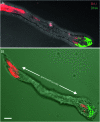Direct evidence for postmeiotic transcription during Drosophila melanogaster spermatogenesis
- PMID: 20610406
- PMCID: PMC2940308
- DOI: 10.1534/genetics.110.118919
Direct evidence for postmeiotic transcription during Drosophila melanogaster spermatogenesis
Abstract
Extensive gene expression during meiosis is a hallmark of spermatogenesis. Although it was generally accepted that RNA transcription ceases during meiosis, recent observations suggest that some transcription occurs in postmeiosis. To further resolve this issue, we provide direct evidence for the de novo transcription of RNA during the postmeiotic phases. These results strengthen the newly emerging notion that postmeiotic transcription is dynamic and integral to the overall process of spermatogenesis.
Figures


Similar articles
-
Comet and cup genes in Drosophila spermatogenesis: the first demonstration of post-meiotic transcription.Biochem Soc Trans. 2008 Jun;36(Pt 3):540-2. doi: 10.1042/BST0360540. Biochem Soc Trans. 2008. PMID: 18482002
-
Stage-specific expression profiling of Drosophila spermatogenesis suggests that meiotic sex chromosome inactivation drives genomic relocation of testis-expressed genes.PLoS Genet. 2009 Nov;5(11):e1000731. doi: 10.1371/journal.pgen.1000731. Epub 2009 Nov 20. PLoS Genet. 2009. PMID: 19936020 Free PMC article.
-
Comparative single-cell analysis of transcriptional bursting reveals the role of genome organization in de novo transcript origination.Proc Natl Acad Sci U S A. 2025 May 6;122(18):e2425618122. doi: 10.1073/pnas.2425618122. Epub 2025 Apr 30. Proc Natl Acad Sci U S A. 2025. PMID: 40305051
-
Studying how flies make sperm--investigating gene function in Drosophila testes.Mol Cell Endocrinol. 2009 Jul 10;306(1-2):66-74. doi: 10.1016/j.mce.2008.11.026. Epub 2008 Dec 3. Mol Cell Endocrinol. 2009. PMID: 19101606 Review.
-
Doubling the rewards: testis ESTs for Drosophila gene discovery and spermatogenesis expression profile analysis.Genome Res. 2000 Dec;10(12):1841-2. doi: 10.1101/gr.169400. Genome Res. 2000. PMID: 11116081 Review. No abstract available.
Cited by
-
Insect population control by homing endonuclease-based gene drive: an evaluation in Drosophila melanogaster.Genetics. 2011 May;188(1):33-44. doi: 10.1534/genetics.111.127506. Epub 2011 Mar 2. Genetics. 2011. PMID: 21368273 Free PMC article.
-
Haploid selection, sex ratio bias, and transitions between sex-determining systems.PLoS Biol. 2018 Jun 25;16(6):e2005609. doi: 10.1371/journal.pbio.2005609. eCollection 2018 Jun. PLoS Biol. 2018. PMID: 29940019 Free PMC article.
-
Haploid Selection Favors Suppressed Recombination Between Sex Chromosomes Despite Causing Biased Sex Ratios.Genetics. 2017 Dec;207(4):1631-1649. doi: 10.1534/genetics.117.300062. Epub 2017 Oct 19. Genetics. 2017. PMID: 29051194 Free PMC article.
-
Loss-of-function analysis reveals distinct requirements of the translation initiation factors eIF4E, eIF4E-3, eIF4G and eIF4G2 in Drosophila spermatogenesis.PLoS One. 2015 Apr 7;10(4):e0122519. doi: 10.1371/journal.pone.0122519. eCollection 2015. PLoS One. 2015. PMID: 25849588 Free PMC article.
-
Haploid selection within a single ejaculate increases offspring fitness.Proc Natl Acad Sci U S A. 2017 Jul 25;114(30):8053-8058. doi: 10.1073/pnas.1705601114. Epub 2017 Jul 11. Proc Natl Acad Sci U S A. 2017. PMID: 28698378 Free PMC article.
References
-
- Barreau, C., E. Benson, E. Gudmannsdottir, F. Newton and H. White-Cooper, 2008. Post-meiotic transcription in Drosophila testes. Development 135 1897–1902. - PubMed
-
- Chang, W. Y., N. A. Winegarden, J. P. Paraiso, M. L. Stevens and J. T. Westwood, 2000. Visualization of nascent transcripts on Drosophila polytene chromosomes using BrUTP incorporation. Biotechniques 29 934–936. - PubMed
-
- Immler, S., 2008. Sperm competition and sperm cooperation: the potential role of diploid and haploid expression. Reproduction 135 275–283. - PubMed
-
- Krawetz, S. A., 2005. Paternal contribution: new insights and future challenges. Nat. Rev. Genet. 6 633–642. - PubMed
Publication types
MeSH terms
Substances
Grants and funding
LinkOut - more resources
Full Text Sources
Molecular Biology Databases

